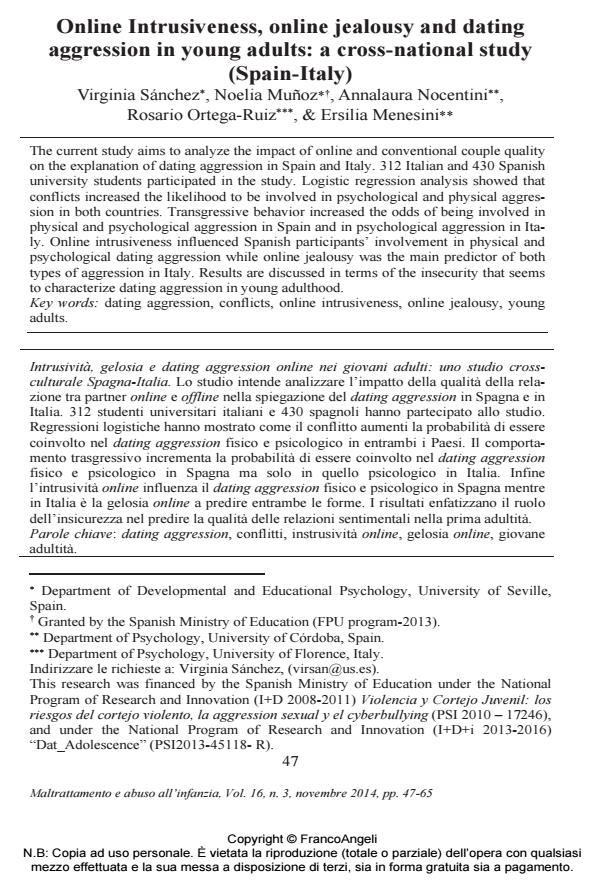Online Intrusiveness, online jealousy and dating aggression in young adults: a cross-national study (Spain-Italy)
Journal title MALTRATTAMENTO E ABUSO ALL’INFANZIA
Author/s Virginia Sànchez, Noelia Munoz, Annalaura Nocentini, Rosario Ortega-Ruiz, Ersilia Menesini
Publishing Year 2014 Issue 2014/3
Language English Pages 19 P. 47-65 File size 108 KB
DOI 10.3280/MAL2014-003004
DOI is like a bar code for intellectual property: to have more infomation
click here
Below, you can see the article first page
If you want to buy this article in PDF format, you can do it, following the instructions to buy download credits

FrancoAngeli is member of Publishers International Linking Association, Inc (PILA), a not-for-profit association which run the CrossRef service enabling links to and from online scholarly content.
The current study aims to analyze the impact of online and conventional couple quality on the explanation of dating aggression in Spain and Italy. 312 Italian and 430 Spanish university students participated in the study. Logistic regression analysis showed that conflicts increased the likelihood to be involved in psychological and physical aggression in both countries. Transgressive behavior increased the odds of being involved in physical and psychological aggression in Spain and in psychological aggression in Italy. Online intrusiveness influenced Spanish participants’ involvement in physical and psychological dating aggression while online jealousy was the main predictor of both types of aggression in Italy. Results are discussed in terms of the insecurity that seems to characterize dating aggression in young adulthood.
Keywords: Dating aggression, conflicts, online intrusiveness, online jealousy, young adults.
- Factors associated with Facebook jealousy in three Spanish-Speaking countries Nieves Moyano, María del Mar Sánchez-Fuentes, Ariana Chiriboga, Jennifer Flórez-Donado, in Sexual and Relationship Therapy /2017 pp.309
DOI: 10.1080/14681994.2017.1397946 - Longitudinal predictors of online dating aggression: Similarities and differences between control and intrusiveness María-Luisa Rodríguez-deArriba, Sónia Caridade, Rosario Del Rey, Virginia Sánchez-Jiménez, in Cyberpsychology: Journal of Psychosocial Research on Cyberspace /2024
DOI: 10.5817/CP2024-1-1 - Longitudinal Risk Profiles for Physical, Psychological, and Sexual Dating Aggression: a Latent Profile Analysis with Spanish Adolescents Annalaura Nocentini, Noelia Muñoz-Fernández, Ersilia Menesini, Virginia Sánchez-Jiménez, in Sexuality Research and Social Policy /2023 pp.426
DOI: 10.1007/s13178-021-00623-5 - Comparing European Emerging Adults Online Romantic Relationships: A Short Longitudinal Study Luana Bruno, Sławomir Pasikowski, Alejandro Iborra Cuéllar, Susanna Annese, Maria Beatrice Ligorio, in Human Arenas /2025
DOI: 10.1007/s42087-025-00505-x - Adolescenti e Sexting: una review della letteratura Gaia Cucci', Maria Giulia Olivari, Emanuela Confalonieri, in MALTRATTAMENTO E ABUSO ALL'INFANZIA 2/2017 pp.119
DOI: 10.3280/MAL2017-002007 - Romantic jealousy: a transcultural comparison between the United States, Colombia, and Mexico Nancy Consuelo Martínez-León, Pablo Vallejo-Medina, Eugene Mathes, Bertha Lucía Avendaño, Víctor Hugo Aviña, Juan Carlos Sierra, in Sexual and Relationship Therapy /2024 pp.1389
DOI: 10.1080/14681994.2023.2288830
Virginia Sànchez, Noelia Munoz, Annalaura Nocentini, Rosario Ortega-Ruiz, Ersilia Menesini, Online Intrusiveness, online jealousy and dating aggression in young adults: a cross-national study (Spain-Italy) in "MALTRATTAMENTO E ABUSO ALL’INFANZIA" 3/2014, pp 47-65, DOI: 10.3280/MAL2014-003004